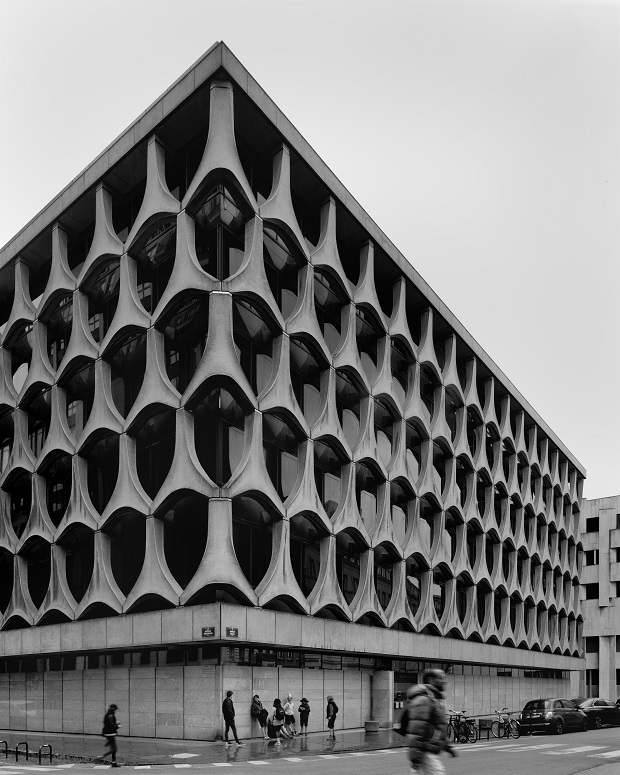- Daily & Weekly newsletters
- Buy & download The Bulletin
- Comment on our articles
Brutalism in Belgium: New book showcases threatened architectural style
There is more to Belgium architecture-wise than the popular Art Nouveau and Art Deco movements. A new book, with help from an Oscar-nominated film, is turning the spotlight on the country’s Brutalist buildings.
This is the head-turning modernist architectural style that emerged in postwar Europe before sweeping around the world. Its immense, spare, concrete structures that epitomised functionalism still divide critics and the public.
But Brutalism and its minimalist aesthetic continue to fascinate, as attested in the epic film The Brutalist about a Hungarian-Jewish architect László Tóth who emigrates to the US after surviving the Holocaust. Although the three-and-a-half long drama by Brady Corbet is fictional, its hero’s Bauhaus training and accomplishments echo the careers of many architects of the period.
The UK is recognised as establishing Brutalism as a movement, with the Norman Engleback-designed 1960s Southbank Centre in London just one outstanding example. Yet it was Swiss-French architect Le Corbusier who coined the term when designing the 1952 masterpiece Unité d’habitation housing project in Marseille, describing his rough-cast material as ‘béton brut’ or raw concrete.

A reaction to the classical nostalgic designs of the 1930s, incarnated by garden cities in the UK and cité-jardins in Belgium, Brutalism emerged as a natural progression of modernism in its desire to strip back traditional decoration to expose the bare structure of a building. Following fascist dictatorships, architects aspired to a Utopian ideal. Concrete was cheap, an accessible material that harnessed a raw beauty and combined with dramatic geometric shapes, symbolised a new ideal for civic buildings of the future.
Belgium boasts its own brutalist heritage, which is detailed in the recently-published Brutalism in Belgium. A collection of buildings from 1950s to 1980s. This book highlights the sorry state of many of these buildings: some are threatened with demolition, others are in urgent need of repair, while a few are simply abandoned.
The 60 selected buildings from around the country have been photographed by architect and photographer Pierrick de Stexhe. His black-and-white images immortalise the predominantly public structures and art. The book also includes texts about Brutalism, the magic properties of concrete and a timeline outlining the development of the movement internationally.
The expansion of higher education in the 1960s was a prime opportunity for the burgeoning Brutalist techniques, as the aesthetic underlined their monumentality and institutionalism. The relocation of the University of Liège to new quarters in Sart-Tilman on the outskirts of the city in the 1960s resulted in a new campus designed by Charles Vandenhove and Claude Strebelle. Its collection of new buildings were conceived to fit harmoniously into the green woodland setting.

In the 1970s, the construction of the new Louvain-la-Neuve campus was another occasion to conceive an integrated modernist site. The former Science Library, built by André Jacqmain, was adorned in facades made out of raw, cast-in-place concrete, giving a stunning effect. Since 2017, the striking building houses the Musée L (pictured above and main image).

Functionality was the hallmark of architect Henri Montois, whose large-scale projects included Brussels’ French-speaking university the ULB’s 1971 Faculty of Medecine. A massive eight-storey quadrilateral forms the main part of the building (pictured) in Rue Evers, embellished by sculptural concrete balconies. Its raw concrete finish has since been painted in beige and the building now houses the federal justice department.

In Wallonia, Namur architect Roger Bastin was behind the renovation of university faculty buildings in his home city; a bold project that transformed the urban landscape. In addition to other major projects such as renovating the library of the Museum Plantin-Moretus in Antwerp, Bastin turned his expert eye to designing a new museum on the site of a former château. It appears to soar above the ancient domain of Mariemont (pictured). Vast cubes contain the main exhibition spaces and a clever use of bay windows provides views of the beautiful park.

Other public buildings adhering to the principles of Brutalism are the Eke Public Library, designed by Ghent architect Juliaan Lampens, and the glorious concrete municipal swimming pool in Ostend designed in 1976 by Paul Felix and Jan Tanghe. It was demolished in February 2024, despite a protest, as renovation was deemed too expensive. Another leisure project was the early 1970s residential Park Atlantis holiday estate (pictured) in De Haan on the coast. The complex has a honeycomb appearance thanks to hexagonal balconies adorning the pyramidal concrete towers. The site was sold in 1997 and transformed into private apartments.

In addition to housing, an important sector bearing Brutalist influence is religious buildings. The grandiosity of their sparse interiors, complemented by simple materials and natural illumination, lend themselves to connecting with spirituality. The pilgrimage chapel of Notre-Dame de Kerselare by Lampens and Rutger Langaskens (pictured), fabricated out of raw concrete, features a triangular structure rising dramatically from the ground and serves as a canopy that protects worshippers from the elements. Natural light fills the interior via overhead openings.
Brutalist techniques were rarely applied to the design of private homes. One exception was Lampens, who was behind a series of inventive and original houses, including the Van Wassenhove home in Sint-Martens-Latem, now managed by the Dhondt-Dhaenens museum. Another is the bunker-like Roelants House (1962) by Willy Van Der Meeren, which occupies a prominent hill in the Flemish Brabant village of Lennik. Completely restored over 10 years ago, the home’s unusual sloping roof makes a bold statement and is surrounded by panoramic views, while the interior contains period features such as wooden partitions and a metal fireplace.

In the Belgian capital, a number of office buildings remain from the period. Among the more appreciated landmarks are the modernist former Lambert Bank by Gordon Bunschaft in Avenue Marnix (now the ING Bank headquarters) and the CBR Building in Chaussée de la Hulpe (pictured). This icon of functionalist architecture, designed by Constantin Brodzki and Marcel Lambrichs - the latter was also behind the beehive-like Marais building - stands out for its simple oval windows. The Brussels Region added the building to its conservation list in 2018 and Fosbury & Sons since converted it into an attractive co-working space and restaurant. Other Brutalist gems in Brussels include the honeycomb Westland and Woluwe shopping centres, Brussels-Congrès station and the Wittockiana book binding museum.
Often reflected against the grey skies of Belgium, the monumental graphic forms and subtle colour contrasts of Brutalism architecture are undoubtedly photogenic, as de Stexhe’s book amply illustrates. The country has a chequered past when it comes to preserving its architectural heritage. Along with active campaign groups, this publication is just one initiative aiming to revive an appreciation of this polarising yet stylist icon of postwar modernism.
Brutalism in Belgium. A collection of buildings from 1950s to 1980s (texts in French and English) is published by Prisme Editions.
For fans of the style, Visit.brussels has compiled a list of six notable Brutalist buildings in the capital.
Photos: (main image) Musée L Place des Sciences by André Jacqmain; Signal of Zellik - Jacques Moeschal 1963 ©SABAM; Musée L Place des Sciences by André Jacqmain; Faculty of Medecine of the ULB - Henri Montois - Michel Boelens 1971; Royal Museum of Mariemont - Roger Bastin 1962-67 ©2024 - SOFAM Belgique; Park Atlantis - Marcel Dubois - Jaminon Associés 1971-74; Our Blessed Lady of Kerselaere Pilgrmage Chapel 1966 ©2024 Juliaan Lampens -Rutger Langaskens - SOFAM Belgique; CGER Building - Marcel lambrichs 1969-74; All photos ©Pierrick de Stexhe

















